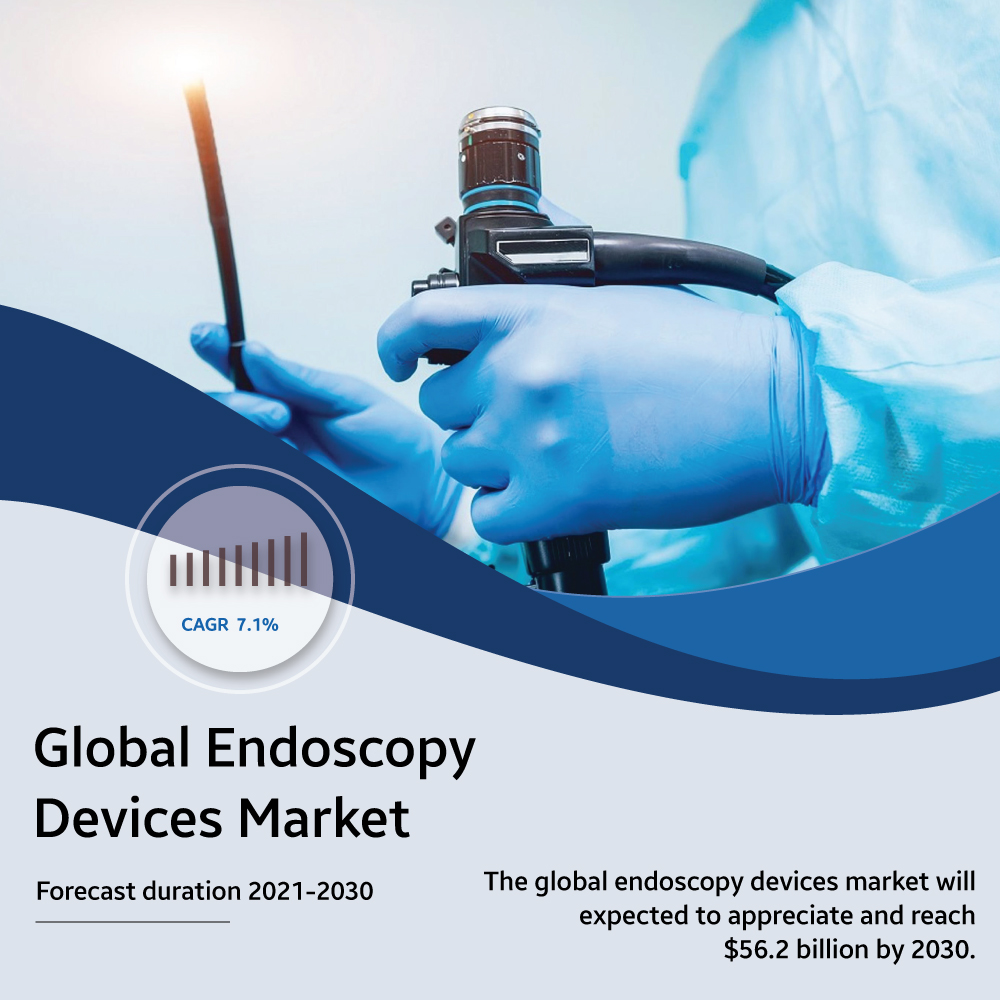Endoscopy tools identify or treat conditions like GERD, gastroesophageal reflux disease (GERD), Crohn’s disease, ulcerative colitis, stomach ulcers, tumors, infections, blockages, and more. The necessity for minimally invasive procedures, the rise of chronic diseases, and technological innovation contribute to the increased adoption of endoscopic devices.
The market for endoscopy devices was worth USD 30.3 billion and will reach USD 56.2 billion by 2030 at a 7.1% CAGR during 2021-2030.
The market for endoscopic devices will expand due to the geriatric population’s predominance of gastroesophageal reflux disorder, gastrointestinal issues, ophthalmic disorders, orthopedic diseases, and cancer, in addition to the rising incidence of chronic diseases.
Impact of COVID-19
During the epidemic, numerous limitations, stringent standards, and adjustments to surgical techniques were implemented. A lack of personnel, a laid-off workforce, and difficulties rehiring were further difficulties. The regulatory and healthcare systems were to organize for the non-surgical approach. Endoscopy volumes were reduced by 83% during the pandemic, according to research. Backlogs of patients and the closure of some endoscopic clinics rendered non-endoscopic approaches unavoidable. Artificial intelligence will play a major role in endoscopic procedures.
Growth Factors
The primary factors driving up demand for endoscopy devices are increasing preference for minimally invasive endoscopic operations and the rising geriatric population. Increased frequency of urological, gastroenterological, respiratory, and gynecological illnesses necessitating endoscopic procedures for diagnosis and treatment is also fueling the market for endoscopes. The market will rise due to an increase in the use of endoscopes and visualization systems in the healthcare sector and technological developments in related areas.
The rise in demand for endoscopic equipment in therapeutic and diagnostic operations and the development of age-related illnesses are other key reasons driving the market’s expansion. Using such tools in diagnosing and treating medical conditions is essential since they allow for little intervention, shortening the recovery time.
The majority of patients requiring endoscopic operations are older adults with conditions like gallstones, intestinal perforations, endometriosis, pelvic abscesses, and liver abscesses. According to a study by the Population Reference Bureau, there were approximately 52 million Americans aged 65 or older in 2018, and it will rise to 95 million by 2060.
Restraints
The industry’s growth rate is impacted by growing product recalls because of faulty systems, higher endoscopy procedure costs like endoscopic retrograde cholangiopancreatography, a shortage of skilled professionals in devices like endoscopy VR simulators, and restricted reimbursement.
Market Segmentation
Product Insights
The endoscopy visualization systems contributed to the largest market share of 36.5% in 2021. It is due to their widespread use during endoscopy procedures and growing application for the visualization and diagnosis of complex disease conditions like cancer, GI disorders, urinary disorders, and lung disorders.
Application Insights
The gastrointestinal endoscopy segment held a maximum market share of 54.7% in 2021. The increased elderly population and the severity of functional gastrointestinal illnesses are responsible for the highest share of this market segment. The availability of technologically sophisticated endoscopes and the growing desire for endoscopic procedures as first-line treatments for the early detection and diagnosis of functional gastrointestinal problems are some of the other key factors promoting the segment’s rise.
End-Use Insights
On the basis of end-user, the hospital segment held a significant market share in 2021, with 48.1% of the revenue share. Hospitals are primary healthcare providers, and the patient population’s growing preference for hospitals for identifying and managing chronic illnesses is another factor driving the segment’s expansion. Additionally, a large number of hospital surgeries, including endoscopic procedures, boost endoscopy device usage, promoting segment growth.
Regional Insights
North America contributed to the largest market in 2021, with 42.3% of the revenue share. This is due to the rising incidence of various chronic diseases, including functional gastrointestinal disorders, cancer, diabetes, and cardiovascular diseases. Additionally, the growing elderly population, which is more susceptible to a number of chronic diseases, is encouraging the use of endoscopic operations in this area. Further driving the market expansion in this region are enhanced healthcare infrastructure and increased awareness of early illness diagnosis employing minimally invasive treatments.
Key Players
- Integrate Endoscopy
- Cantel Medical
- FujiFilm
- Cogentix Medical
- J&J Sevices Inc.
- Interscope Inc.
- Micro-Tech Endoscopy
- KARL STORZ Gmbh & Co. KG
- Richard Wolf
- Olympus
- Pentax Medical
- Shaili Endoscopy
- Stryker
The market for endoscopy devices was worth USD 30.3 billion and will reach USD 56.2 billion by 2030 at a 7.1% CAGR during 2021-2030. The main drivers influencing the market’s growth include the rising need for less invasive procedures, the rising popularity of endoscopes for treatment and diagnostics, and technology advancements leading to improved applications. However, a lack of experienced technicians and infections brought on by a lack of endoscopes limit the market’s growth.















































